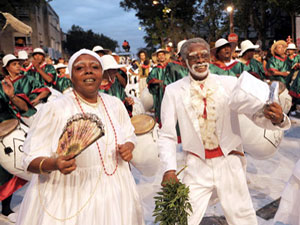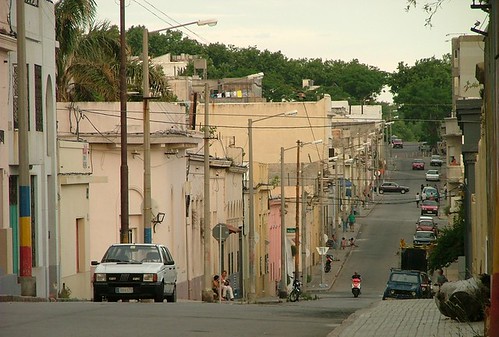Thursday 12 July 2012
black Latino Afro Latino black Hispanic Afro Hispanic
Peru has been slow to tackle inequalities that left African-Peruvians with limited job prospects but that is set to change
from the Guardian
For many tourists visiting Peru, the hotel
doorman is likely to be their first encounter with an African-Peruvian.
It is a job usually filled by young black men in Peru. They also often
occupy roles as chauffeurs or coffin bearers. For activist Jorge
Ramírez, this is another example of the structural racism in Peruvian
society, which means black people have extremely limited job prospects.
"The prejudice is that that's all we're good for," said Ramírez,
president of the Black Association for the Defence and Promotion of
Human Rights (Asonedh).
Now, it is hoped, change is at hand. For
the first time, a government body will be set up dedicated solely to
policies that favour Peru's African-descended population. Between
8% and 10% of Peru's population of nearly 30 million claim African
heritage, a smaller proportion than in Colombia but greater than in
Andean neighbours Ecuador and Bolivia.
Under the umbrella of the
vice-ministry of interculturality, which is part of Peru's culture
ministry, a tiny team of civil servants are working to reduce the
"invisibility" of the descendants of African slaves in the country.
The
approach is three-pronged, explains Rocío Muñoz, one of the team's two
members: a multi-sectorial development plan, which will include public
policies and affirmative action; a nationwide census to provide
up-to-date statistics on the African population and its level of health,
education and employment; and the establishment of a permanent office –
the office for African-descendant policy in Peru.
"Neighbouring
countries have made much greater advances than Peru," says Muñoz.
Bolivia, Brazil, Ecuador and Colombia all recognize their
African-descendant populations within their constitutions and have
dedicated policies for their development, something Peru has yet to do. In a 2011 report, Peru's human rights ombudsman,
La Defensoría del Pueblo,
declared Peru's African-descendant population to be in a situation of
"vulnerability, deferment and invisibility", which impacted negatively
on their human rights, especially in health and education.
It said
that just 2% of those who suffer illnesses attend health clinics or
hospitals. Only 2% of African-Peruvian students complete a university
education, more than half fail to finish secondary education, and 13.8%
do not complete primary education, it said. Hugo Nopo, co-author of
Discrimination in Latin America: An Economic Perspective,
a book sponsored by the Inter-American Development Bank, found that in
Latin America the average wealth gap between the white elite and
indigenous and African-descended people was 38%. He said: "The
inequalities in access to education services later become inequalities
in human capital, in access to labour markets, in the ability to
generate wealth, and in general the ability to live a full and decent
life within society.
"The best policy to provide equal
opportunities is education. The education given to people from the
earliest years is key for their later development. In that sense,
minorities are at a clear disadvantage faced with the majority and
public policies have done little to remedy that situation." Nopo
says state-backed equal opportunities programmes in Colombia, Ecuador
and Bolivia, although "well-intentioned", have done "little or nothing"
to improve the status of African-descended minorities in those
countries. He added: "In Latin America in general, we have to
confront a historic debt. This can't be resolved with short-term
remedial policies like anti-discrimination laws or quotas in different
aspects of public life. The solution has to be long term, attacking the
root of the problem. That's why I'm so convinced that education is the
only way."
The statistics, albeit incomplete, show
African-Peruvians suffer more health problems, and are poorer and less
literate than the national average – in a country where
a third of the population live in poverty, measured as living on $1 or less per person per day. Black
Peruvians do not have the same opportunities as others, says Muñoz, an
expert on African-Latino issues who believes a "colonial way of thinking
continues in what is an apparently democratic society". "Without doubt,
there are a series of stereotypes which have confined Afro-descended
men and women to certain types of work," she says. "There's a real need
to generate opportunities for them. In many cases, they just don't have
other employment options."
In November 2009, Peru became the first Latin American nation
to apologise to its black population for centuries of abuse, exclusion and discrimination. It also admitted discrimination continues in the present day.
But
it was not until Ollanta Humala became president last year with the
promise of "social inclusion for all" that the African-Peruvian issue
was incorporated into a ministerial agenda. The appointment of the African-Peruvian singer
Susana Baca as culture minister
was seen as a good start. She was celebrated as Peru's first black
government minister, although her tenure lasted only five months.
But although Humala officially implemented the
International Labour Organisation's convention 169 on indigenous and tribal communities,
African-Peruvians were left off the agenda until now, says Owan Lay, a
researcher at Peru's vice-ministry for interculturality. On 4
June, African-Peruvian culture day celebrated the birthday of Nicomedes
Santa Cruz, a seminal black poet and musician. But activists argue that,
although their fellow Peruvians appreciate their contribution to music,
culture and sport, they do not recognise their abilities in other
spheres.
"People need to understand that we don't just know how to
dance or play musical instruments; we can also think and fill important
posts," said Ramírez, who is impatient for concrete action to be taken.
"For years we've been waiting, and Afro people continue to be
humiliated, mistreated and excluded. If the state doesn't take action
now, we'll continue to be victims of this structural racism."








